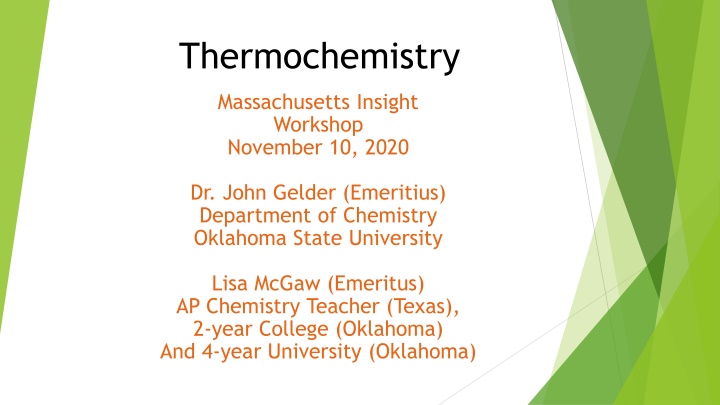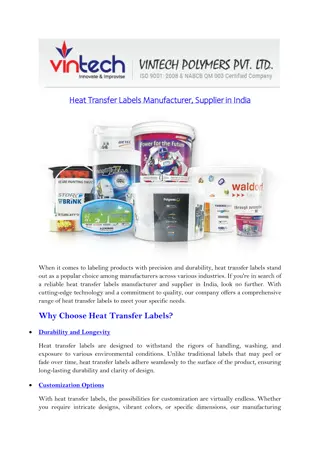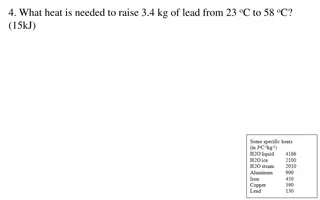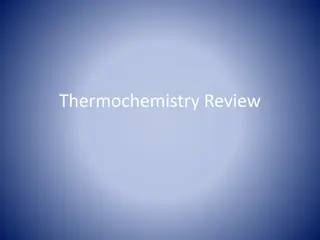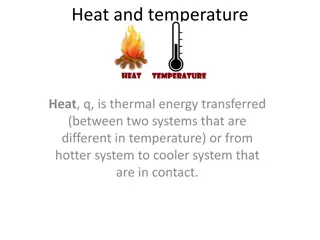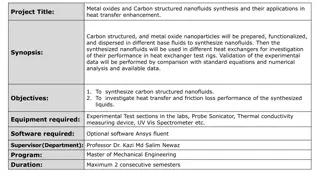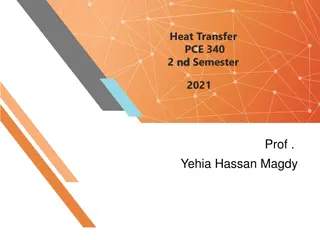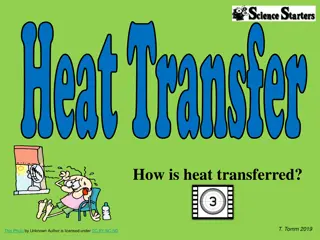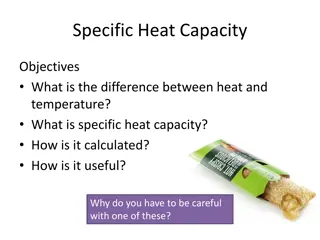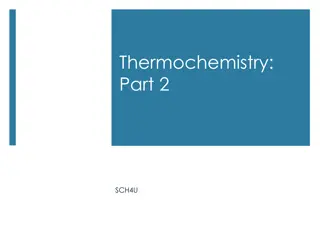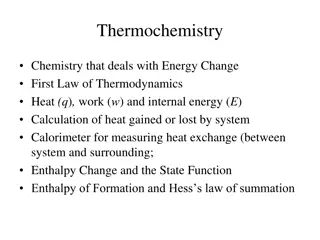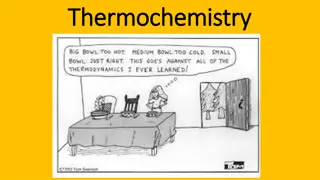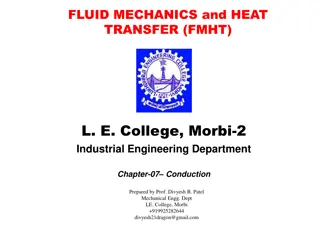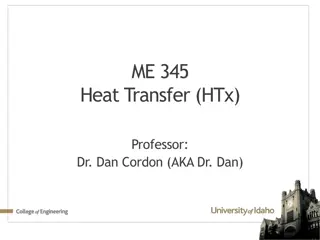Thermochemistry Workshop: Understanding Heat Transfer
Session on thermochemistry covering heat, mass, and temperature relationship. Explore concepts with Dr. John Gelder and Lisa McGaw in an insightful workshop.
Download Presentation

Please find below an Image/Link to download the presentation.
The content on the website is provided AS IS for your information and personal use only. It may not be sold, licensed, or shared on other websites without obtaining consent from the author.If you encounter any issues during the download, it is possible that the publisher has removed the file from their server.
You are allowed to download the files provided on this website for personal or commercial use, subject to the condition that they are used lawfully. All files are the property of their respective owners.
The content on the website is provided AS IS for your information and personal use only. It may not be sold, licensed, or shared on other websites without obtaining consent from the author.
E N D
Presentation Transcript
Thermochemistry Massachusetts Insight Workshop November 10, 2020 Dr. John Gelder (Emeritius) Department of Chemistry Oklahoma State University Lisa McGaw (Emeritus) AP Chemistry Teacher (Texas), 2-year College (Oklahoma) And 4-year University (Oklahoma)
Welcome to the Session on Thermochemistry We will begin this afternoon with some vocabulary and some questions to gain some idea of your intuition about heat, mass and change in temperature ( T). Heat is measured in units of joules (J) or kilojoules (kJ). Heat is one of two ways energy is transferred. Mass is measured in unit of grams. Temperature is measured in units of degrees Celsius ( C). Temperature is a measure of the average kinetic energy of a sample of matter.
Heat, mass, and change in temperature Slide 2 In this experiment q (amount of heat) is constant. What is the relationship between mass and change in temperature?
Heat, mass, and change in temperature Slide 5 In this experiment T (change in temperature) is constant. What is the relationship between heat and mass?
Heat, mass, and change in temperature Slide 7 In the two experiments we have considered we know the following relationships between heat, mass and change in temperature: Experiment #1 : Experiment #2 :
Heat, mass, and change in temperature Slide 9 In this experiment mass is constant. What is the relationship between heat and T?
Introduction to Thermodynamics DCI15.1. Two containers of water are at 20 C initially. One contains 50 mLs and the other 100 mLs. They are each heated with the same source of heat for the same amount of time. If the final temperature of the 50 mLs sample is 50 C what would be the final temperature of the 100 mLs sample? A. B. C. D. E. 50 C 80 C 25 C 100 C 35 C
Introduction to Thermodynamics DCI15.1. Two containers of water are at 20 C initially. One contains 50 mLs and the other 100 mLs. They are each heated with the same source of heat for the same amount of time. If the final temperature of the 50 mLs sample is 50 C what would be the final temperature of the 100 mLs sample? Same amount of heat to both beakers, but different mass. T = 30 for beaker on the left, so T is half or 15 . A. B. C. D. E. 50 C 80 C 25 C 100 C 35 C Mass 1/ T
Introduction to Thermodynamics Two containers each have 50 mLs of water at 20 C initially. They are each heated with the same source of heat. One is heated for ten minutes and the other for five minutes. If the container that was heated for five minutes has a final temperature 30 C what would be the final temperature of the other sample? A. B. C. D. E. 35 C 40 C 60 C 25 C 30 C
Introduction to Thermodynamics Two containers each have 50 mLs of water at 20 C initially. They are each heated with the same source of heat. One is heated for ten minutes and the other for five minutes. If the container that was heated for five minutes has a final temperature 30 C what would be the final temperature of the other sample? A. B. C. D. E. 35 C 40 C 60 C 25 C 30 C Both beakers contain the same amount of water. Twice the heat to one. T is 10 for smaller amount of heat, than T = 20 for larger amount. Q(heat) T
Introduction to Thermodynamics Two containers of water are at 20 C initially. One contains 50 g of water and is heated by a source for a specified time to a final temperature of 30 C. The second container has an unknown amount of water and is heated with the same source to 30 C. However, it takes twice as long to get to this final temperature. How much water is in this container? A. B. C. D. E. 100 g 25 g 30 g 50 g 75 g
Introduction to Thermodynamics Two containers of water are at 20 C initially. One contains 50 g of water and is heated by a source for a specified time to a final temperature of 30 C. The second container has an unknown amount of water and is heated with the same source to 30 C. However, it takes twice as long to get to this final temperature. How much water is in this container? A. B. C. D. E. 100 g 25 g 30 g 50 g 75 g Twice the heat is added to one beaker to reach the same final temperature ( T). So the beaker must have twice the mass. Q(heat) Mass
Introduction to Thermodynamics So we have established the following relationships; Mass 1/ T at constant q q(heat) T at constant mass q(heat) mass at constant T So q(heat) mass T Heat is directly proportional to the mass times the change in temperature.
Introduction to Thermodynamics 50 mLs of water at 80 C is added to 50 mLs of water at 20 C. What would be the final temperature? A. B. C. D. E. 60 C 40 C 30 C 20 C 50 C
Introduction to Thermodynamics 50 mLs of water at 80 C is added to 50 mLs of water at 20 C. What would be the final temperature? A. B. C. D. E. 60 C 40 C 30 C 20 C 50 C
Introduction to Thermodynamics 50 mLs of water at 80 C is added to 50 mLs of water at 20 C. What would be the final temperature? A. B. C. D. E. 60 C 40 C 30 C 20 C 50 C qhot water + qcold water = 0 qhot water = qcold water masshot water Thot water = masscold water Tcold water 50. g Thot water = 50. g Tcold water 50. g (Tfinal 80.0 ) = 50. g (Tfinal 20.0 ) 2Tfinal = 100 Tfinal = 50
Introduction to Thermodynamics 50 mLs of water at 80 C is added to 100 mLs of water at 20 C. What would be the final temperature? A. B. C. D. E. 70 C 40 C 30 C 60 C 50 C
Introduction to Thermodynamics 50 mLs of water at 80 C is added to 100 mLs of water at 20 C. What would be the final temperature? A. B. C. D. E. 70 C 40 C 30 C 60 C 50 C
Introduction to Thermodynamics 50 mLs of water at 80 C is added to 100 mLs of water at 20 C. What would be the final temperature? A. B. C. D. E. 70 C 40 C 30 C 60 C 50 C qhot water = qcold water masshot water Thot water = masscold water Tcold water 50. g Thot water = 100. g Tcold water 50. g (Tfinal 80.0 ) = 100. g (Tfinal 20.0 ) (Tfinal 80.0 ) = 2 (Tfinal 20.0 ) 3Tfinal = 120 Tfinal = 40
Introduction to Thermodynamics 50 g of water at 80 C is added to 50 g of ethyl alcohol at 20 C. What would be the approximate final temperature? A. B. C. D. E. 60 C 40 C 30 C 20 C 50 C
Introduction to Thermodynamics 50 g of water at 80 C is added to 50 g of ethyl alcohol at 20 C. What would be the approximate final temperature? A. B. C. D. E. 60 C 40 C 30 C 20 C 50 C TWO DIFFERENT SUBSTANCES! Experimentally the final temperature is determined to be close to 60 .
Introduction to Thermodynamics q(heat) mass T How do we make this an equality? We must introduce a constant .in this case the constant is called the specific heat, SH, q(heat) = mass SH T Specific heat is the amount of heat required to raise the temperature of 1 gram of a substance 1 C.
Introduction to Thermodynamics Specific Heats of Substances Compound Specific Heat (J C-1g-1) 4.184 2.03 0.89 0.71 0.45 0.14 0.917 2.46 H2O(l) H2O(s) Al(s) C(s) Fe(s) Hg(l) O2(g) CH3CH2OH
Introduction to Thermodynamics Specific Heats of Substances Exp Heat Added (J) 1000 2000 3000 1000 1700 Mass (g) Ti Tf ( C) ( C) 1 2 3 4 5 10.0 10.0 10.0 20.0 45.0 20.0 20.0 20.0 20.0 25.0 43.9 67.8 91.7 Note: All five experiments use the same substance.
Introduction to Thermodynamics Specific Heats of Substances Exp Heat Added (J) 1000 2000 3000 1000 1700 Mass (g) Ti Tf Constant T ( C) ( C) ( C) 1 2 3 4 5 10.0 10.0 10.0 20.0 45.0 20.0 20.0 20.0 20.0 25.0 43.9 67.8 91.7 32.0 23.9 47.8 71.7 12.0 4.184 4.184 4.184 4.184 4.184 Note: All five experiments use the same substance.
Introduction to Thermodynamics Specific Heats of Substances Exp Heat Added (J) 1000 2000 3000 1000 1700 Mass (g) Ti Tf Constant T ( C) ( C) ( C) 1 2 3 4 5 10.0 10.0 10.0 20.0 45.0 20.0 20.0 20.0 20.0 25.0 43.9 67.8 91.7 32.0 34.0 23.9 47.8 71.7 12.0 9.0 4.184 4.184 4.184 4.184 4.184 Note: All five experiments use the same substance.
Heat, mass, and change in temperature Slide 10 In the three experiments we have considered we know the following relationships between heat, mass and change in temperature: Experiment #1 : Experiment #2 : Experiment #3 :
Heat, mass, and change in temperature Slide 11 In the three experiments we have considered we know the following relationships between heat, mass and change in temperature: Experiment #1 : Experiment #2 : Experiment #3 : With these three experiments we can see a connection between heat, mass and change in temperature.
Heat, mass, and change in temperature Slide 12 In the three experiments we have considered we know: Experiment #1 : Experiment #2 : Experiment #3 : With these three experiments we can see a connection between heat, mass and change in temperature.
Heat, mass, change in temperature and specific heat Slide 13 In the three experiments we have considered we know: Experiment #1 : Experiment #2 : Experiment #3 : With these three experiments we can see a connection between heat, mass and change in temperature.
Heat, mass, change in temperature and specific heat Slide 14 Very important relationship q = mass c T c has units of joules g-1 C-1 DANGER!! We must be very careful using this relationship! Calculates the magnitude of the heat released or absorbed but not the sign of q.
Heat, mass, change in temperature and specific heat Slide 14 Using q = mass c T To calculate the magnitude of the heat released or absorbed but not the sign of q. For example, an exothermic reaction in water will cause the aqueous solution to increase in temperature so Tfinal is larger than Tinitialand T would be a positive number. The mass of the solution and the specific heat of the solution are also positive, so using the equation q = mass c T to calculate q yields a positive value for q! For exothermic reactions q must be negative.
Heat, mass, change in temperature and specific heat Slide 16 First Law of Thermodynamics Experiments that we do in AP chemistry. Mix hot and cold water Add a hot piece of metal to water at room temperature Add an ionic solid to water Mix a strong acid with a strong base Mix a strong acid with a reactive metal
Heat, mass, change in temperature and specific heat Slide 17 First Law of Thermodynamics Experiments that we do in AP chemistry. Mix hot and cold water; Add a hot piece of metal to water at room temperature; qhot metal = qcold water Add an ionic solid to water; qdissolution = qsolution qhot water = qcold water Mix a strong acid with a strong base ; qneutralization = qsolution Mix a strong acid with a reactive metal; qreaction = qsolution
2013 AP Chemistry Exam Question 3 Slide 1 MgO(s) + 2 H+(aq) Mg2+(aq) + H2O(l) 3. A student was assigned the task of determining the enthalpy change for the reaction between solid MgO and aqueous HCl represented by the net-ionic equation above. The student uses a polystyrene cup calorimeter and performs four trials. Data for each trial are shown in the table below. Trial Volume of 1.0 M HCl (mL) Added (g) 1 100.0 0.25 2 100.0 0.50 3 100.0 0.25 4 100.0 0.50 Mass of MgO(s) Initial Temperature of Solution ( C) 25.5 25.0 26.0 24.1 Final Temperature of Solution ( C) 26.5 29.1 28.1 28.1 (a) Which is the limiting reagent in all four trials, HCl or MgO? Justify your answer. (b) The data in one of the trials is inconsistent with the data in the other three trials. Identify the trial with inconsistent data and draw a line through the data from that trial in the table above. Explain how you identified the inconsistent data.
2013 AP Chemistry Exam Question 3 Slide 2 MgO(s) + 2 H+(aq) Mg2+(aq) + H2O(l) 3. A student was assigned the task of determining the enthalpy change for the reaction between solid MgO and aqueous HCl represented by the net-ionic equation above. The student uses a polystyrene cup calorimeter and performs four trials. Data for each trial are shown in the table below. Trial Volume of 1.0 M HCl (mL) Added (g) 1 100.0 0.25 2 100.0 0.50 3 100.0 0.25 4 100.0 0.50 Mass of MgO(s) Initial Temperature of Solution ( C) 25.5 25.0 26.0 24.1 Final Temperature of Solution ( C) 26.5 29.1 28.1 28.1 (a) Which is the limiting reagent in all four trials, HCl or MgO? Justify your answer.
2013 AP Chemistry Exam Question 3 Slide 3 MgO(s) + 2 H+(aq) Mg2+(aq) + H2O(l) 3. A student was assigned the task of determining the enthalpy change for the reaction between solid MgO and aqueous HCl represented by the net-ionic equation above. The student uses a polystyrene cup calorimeter and performs four trials. Data for each trial are shown in the table below. Trial Volume of 1.0 M HCl (mL) Added (g) 1 100.0 0.25 2 100.0 0.50 3 100.0 0.25 4 100.0 0.50 Mass of MgO(s) Initial Temperature of Solution ( C) 25.5 25.0 26.0 24.1 Final Temperature of Solution ( C) 26.5 29.1 28.1 28.1 (a) Which is the limiting reagent in all four trials, HCl or MgO? Justify your answer. (b) The data in one of the trials is inconsistent with the data in the other three trials. Identify the trial with inconsistent data and draw a line through the data from that trial in the table above. Explain how you identified the inconsistent data.
2013 AP Chemistry Exam Question 3 Slide 4 MgO(s) + 2 H+(aq) Mg2+(aq) + H2O(l) 3. A student was assigned the task of determining the enthalpy change for the reaction between solid MgO and aqueous HCl represented by the net-ionic equation above. The student uses a polystyrene cup calorimeter and performs four trials. Data for each trial are shown in the table below. Trial Volume of 1.0 M HCl (mL) Added (g) 1 100.0 0.25 2 100.0 0.50 3 100.0 0.25 4 100.0 0.50 Mass of MgO(s) Initial Temperature of Solution ( C) 25.5 25.0 26.0 24.1 Final Temperature of Solution ( C) 26.5 29.1 28.1 28.1 (a) Which is the limiting reagent in all four trials, HCl or MgO? Justify your answer. (b) The data in one of the trials is inconsistent with the data in the other three trials. Identify the trial with inconsistent data and draw a line through the data from that trial in the table above. Explain how you identified the inconsistent data.
2013 AP Chemistry Exam Question 3 Slide 5 MgO(s) + 2 H+(aq) Mg2+(aq) + H2O(l) 3. A student was assigned the task of determining the enthalpy change for the reaction between solid MgO and aqueous HCl represented by the net-ionic equation above. The student uses a polystyrene cup calorimeter and performs four trials. Data for each trial are shown in the table below. Trial Volume of 1.0 M HCl (mL) Added (g) 1 100.0 0.25 2 100.0 0.50 3 100.0 0.25 4 100.0 0.50 Mass of MgO(s) Initial Temperature of Solution ( C) 25.5 25.0 26.0 24.1 Final Temperature of Solution ( C) 26.5 29.1 28.1 28.1 For parts (c) and (d), use the data from one of the other three trials (i.e., not from the trial you identified in part (b) above). Assume the calorimeter has a negligible heat capacity and that the specific heat of the contents of the calorimeter is 4.18 J/(g C). Assume that the density of the HCl(aq) is 1.0 g/mL. (c) Calculate the magnitude of q, the thermal energy change, when the MgO was added to the 1.0 M HCl(aq). Include units with your answer. (d) Determine the student s experimental value of H for the reaction between MgO and HCl in units of kJ/molrxn.
2013 AP Chemistry Exam Question 3 Slide 6 MgO(s) + 2 H+(aq) Mg2+(aq) + H2O(l) 3. A student was assigned the task of determining the enthalpy change for the reaction between solid MgO and aqueous HCl represented by the net-ionic equation above. The student uses a polystyrene cup calorimeter and performs four trials. Data for each trial are shown in the table below. Trial Volume of 1.0 M HCl (mL) Added (g) 1 100.0 0.25 2 100.0 0.50 3 100.0 0.25 4 100.0 0.50 Mass of MgO(s) Initial Temperature of Solution ( C) 25.5 25.0 26.0 24.1 Final Temperature of Solution ( C) 26.5 29.1 28.1 28.1 For parts (c) and (d), use the data from one of the other three trials (i.e., not from the trial you identified in part (b) above). Assume the calorimeter has a negligible heat capacity and that the specific heat of the contents of the calorimeter is 4.18 J/(g C). Assume that the density of the HCl(aq) is 1.0 g/mL. (c) Calculate the magnitude of q, the thermal energy change, when the MgO was added to the 1.0 M HCl(aq). Include units with your answer. qrxn = -qsolution = -(mass c T)solution
2013 AP Chemistry Exam Question 3 Slide 7 MgO(s) + 2 H+(aq) Mg2+(aq) + H2O(l) 3. A student was assigned the task of determining the enthalpy change for the reaction between solid MgO and aqueous HCl represented by the net-ionic equation above. The student uses a polystyrene cup calorimeter and performs four trials. Data for each trial are shown in the table below. Trial Volume of 1.0 M HCl (mL) 100.0 100.0 100.0 100.0 Mass of MgO(s) Added (g) 0.25 0.50 0.25 0.50 Initial Temperature of Solution ( C) 25.5 25.0 26.0 24.1 Final Temperature of Solution ( C) 26.5 29.1 28.1 28.1 1 2 3 4 For parts (c) and (d), use the data from one of the other three trials (i.e., not from the trial you identified in part (b) above). Assume the calorimeter has a negligible heat capacity and that the specific heat of the contents of the calorimeter is 4.18 J/(g C). Assume that the density of the HCl(aq) is 1.0 g/mL. (c) Calculate the magnitude of q, the thermal energy change, when the MgO was added to the 1.0 M HCl(aq). Include units with your answer. qrxn = -qsolution = -(mass c T)solution
2013 AP Chemistry Exam Question 3 Slide 8 MgO(s) + 2 H+(aq) Mg2+(aq) + H2O(l) 3. A student was assigned the task of determining the enthalpy change for the reaction between solid MgO and aqueous HCl represented by the net-ionic equation above. The student uses a polystyrene cup calorimeter and performs four trials. Data for each trial are shown in the table below. Trial Volume of 1.0 M HCl (mL) Added (g) 1 100.0 0.25 2 100.0 0.50 3 100.0 0.25 4 100.0 0.50 Mass of MgO(s) Initial Temperature of Solution ( C) 25.5 25.0 26.0 24.1 Final Temperature of Solution ( C) 26.5 29.1 28.1 28.1 (c) Calculate the magnitude of q, the thermal energy change, when the MgO was added to the 1.0 M HCl(aq). Include units with your answer. qrxn = -qsolution = -(mass c T)solution (d) Determine the student s experimental value of H for the reaction between MgO and HCl in units of kJ/molrxn.
2013 AP Chemistry Exam Question 3 Slide 9 MgO(s) + 2 H+(aq) Mg2+(aq) + H2O(l) 3. A student was assigned the task of determining the enthalpy change for the reaction between solid MgO and aqueous HCl represented by the net-ionic equation above. The student uses a polystyrene cup calorimeter and performs four trials. Data for each trial are shown in the table below. Trial Volume of 1.0 M HCl (mL) Added (g) 1 100.0 0.25 2 100.0 0.50 3 100.0 0.25 4 100.0 0.50 Mass of MgO(s) Initial Temperature of Solution ( C) 25.5 25.0 26.0 24.1 Final Temperature of Solution ( C) 26.5 29.1 28.1 28.1 (c) Calculate the magnitude of q, the thermal energy change, when the MgO was added to the 1.0 M HCl(aq). Include units with your answer. qrxn = -qsolution = -(mass c T)solution (d) Determine the student s experimental value of H for the reaction between MgO and HCl in units of kJ/molrxn. (Using Trial 2 data) Hrxn = qrxn /molrxn
2013 AP Chemistry Exam Question 3 Slide 10 MgO(s) + 2 H+(aq) Mg2+(aq) + H2O(l) 3. A student was assigned the task of determining the enthalpy change for the reaction between solid MgO and aqueous HCl represented by the net-ionic equation above. The student uses a polystyrene cup calorimeter and performs four trials. Data for each trial are shown in the table below. Trial Volume of 1.0 M HCl (mL) Added (g) 1 100.0 0.25 2 100.0 0.50 3 100.0 0.25 4 100.0 0.50 Mass of MgO(s) Initial Temperature of Solution ( C) 25.5 25.0 26.0 24.1 Final Temperature of Solution ( C) 26.5 29.1 28.1 28.1 (c) Calculate the magnitude of q, the thermal energy change, when the MgO was added to the 1.0 M HCl(aq). Include units with your answer. qrxn = -qsolution = -(mass c T)solution (d) Determine the student s experimental value of H for the reaction between MgO and HCl in units of kJ/molrxn. Hrxn = qrxn /molrxn
